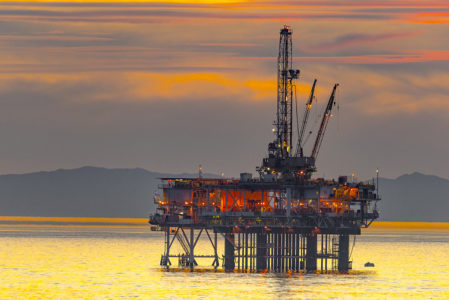Stanford’s Deborah Sivas on the California Oil Spill and Challenges of Regulating Off-Shore Drilling
As of October 5, the leak from Amplify Energy’s pipeline, located approximately three miles off of the Newport Beach, California, coast, was reported to have spilled 140,000 gallons of oil into the Pacific Ocean, causing a 13-mile slick—and the disruption of precious coastal beaches and wildlife habitats. Here, environmental law expert, Professor Deborah Sivas, discusses the spill and regulations surrounding off-shore oil drilling.
Can you talk about the damage this most recent oil spill may cause to the California coastline and the species who call the waters home?

We are already seeing damage to marine life, birds, and critical coastal wetlands along the Orange County coastline, moving south with the current. If the winds shift from onshore to offshore, the spill may continue to spread out, expanding its impacts. Assuming that the Amplify pipeline leak is now contained—and I think that is still just an assumption—this spill will be roughly on par in size with the 2015 pipeline spill at Refugio Beach in Santa Barbara, which closed beaches for weeks and killed hundreds of birds and marine mammals, as well as countless other marine species. I don’t think we really know the full extent of the ecological damage from these spills because we only see the most obvious victims.
And who will be held legally liable for the cleanup?
The pipeline owner and operator are on the hook, legally, for the costs of cleanup and the resulting damages to natural resources. There are a number of state and federal laws that impose liability on the pipeline owner, including the federal Oil Pollution Act (added to the Clean Water Act after the Valdez oil spill) and on the state side, the Porter-Cologne Water Quality Act and the Lempert-Keene- Seastrand Oil Spill Prevention and Response Act. Using these authorities, the state and federal regulators went after the pipeline owner for the Refugio spill and finally settled that matter last year for $60 million.
There are some news reports that a ship anchor may have punctured the Amplify pipeline. If that speculation proves true—and here again, that is still speculation—Amplify could try to recovery some of these costs from the ship owner.
How is coastal oil drilling regulated? Is it by the state? Or federal jurisdiction? Or both? I thought California had some of the toughest laws in the country for regulating oil drilling off its coast.
It is a little complicated. Since the big 1969 Santa Barbara oil spill, California has prohibited new offshore oil drilling in state waters, but these waters only extend three miles from the shoreline. The federal government has jurisdiction over the submerged lands and waters beyond three miles. There has been no offshore oil leasing of federal lands since about the mid-1980s, although the Trump Administration did try to revive federal leasing, including off the coast of California.

The Amplify platform off the coast of Orange County was built around 1980, is located in federal waters, and operates pursuant to federal leases, permits, and safety regulations. Oil that is partially processed at that platform is then pumped by pipeline to an onshore facility for additional processing, and it is apparently one of those pipelines that ruptured last week. So, although new offshore development is currently not allowed in either state or federal waters, the Amplify platform and the nearby rigs it supports, were constructed just before the federal moratorium went into effect.
As to the pipeline itself, in federal waters, it is subject to environmental safety regulation by the federal Bureau of Safety and Environmental Enforcement. Where the pipeline crosses through near-shore state waters, it is subject to a lease of the state submerged tidelands from the California State Lands Commission, which has its own Marine Resources Management Division that oversees pipeline safety. So, safety jurisdiction over the pipeline is the responsibility of both the feds and the state.
It has been reported that the pipeline was more than 40 years old. Are these pipes inspected and checked for a sort of expiration date? I read that they are usually designed for a 25-year life.
Both the federal and state regulations provide for period inspections of these offshore oil pipelines and there is supposed to be leak detection monitoring. But if the Amplify pipeline was built at the same time as the platform, around 1980, corrosion can be a real issue, especially in the harsh saltwater environment. I’m not an engineer, but I do think I have seen studies suggesting that risk of failure increases substantially as pipelines approach 40 years old. For instance, the 28-year-old pipeline that leaked at Refugio State Beach in 2015 was found to be badly corroded. For such aging infrastructure, inspection, monitoring, and maintenance are key.
Can oil drilling off our shores be done safely? Are our regulations tough enough?
More than 50 years after the big Santa Barbara spill, polling shows a majority of Californians continue to believe that offshore oil drilling is too risky. Well blowouts like the 2010 BP spill in the Gulf, spills from ship accidents like the Exxon Valdez grounding in Alaska and the 2007 Cosco Busan bridge collision in San Francisco Bay, and pipeline ruptures like Refugio and now Orange County, all show that offshore oil activity poses non-trivial risks to the marine ecosystem. After many of these incidents, legislators or regulators will announce plans for stricter regulations, but enforcement remains problematic and there has been backsliding, especially during the Trump years.
The split in regulation seems to be particularly problematic. Are existing leases hard to end?
When these types of accidents occur, there are always calls for permanently ending offshore drilling, but it isn’t that easy. Existing offshore wells and platforms, mostly in federal waters, hold leases and permits. The state has little say over existing operations in federal waters. And even if the federal government were suddenly inclined to phase out existing facilities, doing so is challenging and could be quite expensive. The existing leases and permits are, legally speaking, property interests. Presumably, the government would have to pay significant compensation to the leaseholders if it wanted to shut down those operations. That’s one reason conservation interests are so strenuously fighting any new leases; once an operator gains a federal lease, it becomes much difficult to stop activities.
Deborah A. Sivas is the Luke W. Cole Professor of Environmental Law at Stanford, the founding director of its Environmental Law Clinic, director of its Environmental and Natural Resources Law and Policy Program, and a senior fellow at the Stanford Woods Institute for the Environment.
